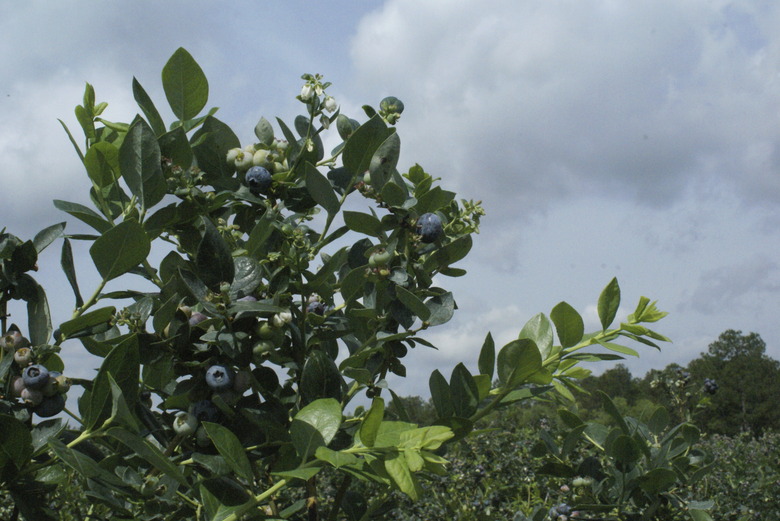How To Grow Blueberries In Michigan
When it comes to growing blueberries (Vaccinium spp.), Michigan is just about the best place on the planet. The state is the top commercial producer of highbush blueberries (Vaccinium corymbosum), which are generally hardy in U.S. Department of Agriculture plant hardiness zones 3 to 7, and at least in certain parts of the state, conditions are just right for blueberries in the home garden, too.
Step 1
Blueberries need well-drained, acidic soil, and southwest Michigan has plenty of it. Blueberries do best when soil pH is between 4.5 and 5, and that pH level is common in the southwest part of the state. In areas where the pH level is higher, soil amendments may be able to lower the pH to an optimal level; adding 1 to 2 pounds of sulfur per 100 square feet will lower soil pH by one point. If the native soil pH is higher than 7, amendments probably won't be sufficient to adjust the pH; in that case, plant blueberries in a raised bed made up of two parts acidic compost to one part loam.
Site Selection
Step 1
Blueberries prefer full sun and moist but well-drained soil. They do especially well in southwest Michigan, where the high water table in combination with the sandy soil makes for ideal conditions, but they can grow elsewhere in the state with proper water management. The bushes have shallow root systems and need frequent irrigation; stress from too little water can kill young bushes. They won't tolerate saturated soils, though, so keep them away from areas that are prone to flooding, and don't over water. In general, bushes should get about 2 inches of water per week. Plant bushes in late spring, and space them 3 to 4 feet apart.
Step 2
- Blueberries need well-drained, acidic soil, and southwest Michigan has plenty of it.
- Blueberries prefer full sun and moist but well-drained soil.
- They do especially well in southwest Michigan, where the high water table in combination with the sandy soil makes for ideal conditions, but they can grow elsewhere in the state with proper water management.
Cultivars and Cold Hardiness
Step 1
Much of southern Michigan falls into U.S. Department of Agriculture hardiness zone 5, and some areas near the lake shores enjoy a USDA zone 6 climate. However, parts of the upper peninsula and the northern lower peninsula fall into zones 3 and 4, so blueberries planted there need to be especially cold hardy. In the colder areas north of Muskegon and Saginaw Bay, half-high varieties (Vaccinium corymbosum x Vaccinium angustifolium), hybrids of highbush and lowbush blueberries (Vaccinium angustifolium), are the best choices; "Northblue" and "Chippewa" are popular varieties that are hardy in USDA zones 3 to 7. Those cultivars work well in southern Michigan, too, as do the highbush varieties "Draper," which is hardy in USDA zones 5 to 7, and "Liberty," which is hardy in USDA zones 4 to 7.
Step 2
Fertilization Needs
Step 1
Blueberries like acidic fertilizer in which the nitrogen is in the form of ammonium sulfate rather than calcium nitrate; fertilizers developed for azaleas and rhododendrons work well. The best time to fertilize is early in the season, just as the blooming period begins, so that both new growth and fruit production is supported. If you fertilize after the plant has bloomed and set fruit, you'll encourage new growth late in the season that will be vulnerable to injury during the winter. To fertilize new plants, apply 1/10 pound of a dry 12-12-12 fertilizer in a 6-inch circle around the base of the plant about a month after planting. Increase the amount to 2/10 pound per plant in the second year, applying the fertilizer when blooming begins. In subsequent years, apply 3/10 pound at the beginning of bloom, and then follow up with two more applications of 2/10 pound each spaced six weeks apart. Always water thoroughly after fertilizing.
Step 2
- Much of southern Michigan falls into U.S. Department of Agriculture hardiness zone 5, and some areas near the lake shores enjoy a USDA zone 6 climate.
- However, parts of the upper peninsula and the northern lower peninsula fall into zones 3 and 4, so blueberries planted there need to be especially cold hardy.
